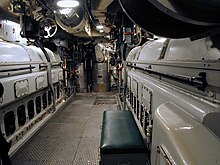Fairbanks Morse 38 8-1/8 diesel engine
The Fairbanks-Morse 38 8-1/8 is a
Specifications

The 38 8-1/8 engines are inline diesel engines, with combustion occurring between two opposed pistons within a single cylinder liner. The engine has a bore of 8-1/8 inches (206.4 mm), a stroke of 10 inches (254.0 mm) for each piston, and the cylinder height is 38 inches (970 mm). The engine block is of dry block construction.[1] They have been manufactured with between four and twelve cylinders, depending on application.
Vertical force is transmitted from the opposed trunk style pistons to either an upper or lower crankshaft. The two crank shafts are geared together by a vertical drive shaft. Pistons are removed by either removing the top crankshaft, and removing from the top, or by removing through the lower crank case access doors.[1]
The lower crankshaft is timed 12 degrees before the upper crankshaft in order to expel exhaust gasses prior to the admittance of scavenging air. Fresh air cleanses the cylinders of remaining exhaust prior to the exhaust ports being covered by the rising lower piston.[3]
As this engine is of two stroke opposed-piston design, unlike most four stroke engines it has no cylinder head nor mechanical valves: ports in the cylinder liners provide incoming air and exhaust. The two
Applications
North America


Historically, the opposed-piston engine was used in U.S.
Railroad Service
During the 1940s and 1950s, Fairbanks-Morse attempted to market their opposed-piston powered line of
Fairbanks-Morse exited the locomotive market in 1963.
Certain ice-breaking class vessels of the Canadian Coast Guard used Fairbanks Morse opposed piston engines in the operation of a diesel electric/gas-turbine electric operation. The former CCGS Norman McLeod Rogers, currently[when?] sailing under the Chilean flag as Contraalmirante Oscar Viel Toro is one such example.[15]
Current[
The Fairbanks Morse Opposed Piston engine is also used as a stationary power generator engine, both in primary and standby duties.[16]
Soviet Union
The 38 8-1/8 was reverse-engineered in the USSR and used as a primary engine for railroad locomotives. The first Soviet mass-produced diesel locomotive,
13D100 variant was used as a generating set in diesel-electric Dobrynya Nikitich-class icebreakers and their derivatives.
Developments
The 38 8-1/8 underwent development to provide for better fuel efficiency and lessen emissions. In the 1990s, Fairbanks-Morse applied their "Enviro Design" technology to run the opposed piston engine as a dual diesel and natural gas engine. This system injects a small 'pilot' amount of diesel fuel to aid in the combustion of natural gas within the combustion chamber while controlled with computerized electronics.[17]
See also
References
- ISBN 1-55750-263-3.
- ^ Submarine Main Propulsion Diesels. Department of the Navy, NAVPERS. 1946.
- ^ "Fairbanks-Morse Company Model 38D-8-1/8 Opposed Piston Engine". Tugboat Enthusiasts Society of the Americas. Archived from the original on February 21, 2013. Retrieved April 1, 2012.
- LCCN 66-22894.
- ^ Silverstone, Paul H (1966). U.S. Warships of World War II. Doubleday and Company. pp. 167–170, 176, 378.
- ISBN 0517-67963-9.
- ISBN 1-55750-132-7.
- ^ Aldag Jr., Robert (March 1987). "F-M Against the Odds Part 1: How Fairbanks Morse Got Into the Locomotive Business". Trains. Kalmbach Publishing Co.
- ^ a b c d e f Aldag Jr., Robert (April 1987). "F-M Against the Odds Part 2: Train Master Triumph, Speed Merchant Flop, OP Paradox". Trains. Kalmbach Publishing Co.
- ^ Pinkepank(73) pages 323-324
- ^ "Norman McLeod Rogers". Shipping World and Shipbuilder. 3841. 163. January 1970.
- ^ Steigers, J.A. (2002). "Demonstrating the Use of Fish Oil as Fuel in a Large Stationary Engine".
{{cite journal}}: Cite journal requires|journal=(help) - ^ "Enviro-Design | Fairbanks Morse Engine". Fairbanks Morse Engine. Retrieved April 16, 2012.
External links
- Official Fairbanks Morse Website
- "Fairbanks-Morse 38D8 Diesel Locomotive". PSRM Diesel Locomotives. Retrieved October 25, 2014.
The most fuel consuming beast on earth was the morse-Fairbanks 38
